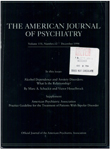White matter hyperintensity signals in psychiatric and nonpsychiatric subjects
Abstract
OBJECTIVE: As part of an ongoing study investigating the relationship between brain morphology/function and neuropsychological performance in psychopathology, the authors conducted brain magnetic resonance imaging (MRI) studies to investigate the prevalence and psychiatric significance of white matter hyperintensity signals. METHOD: Brain MRI acquisition was done with 0.5 and 1.5 Tesla Philips scanners. Psychiatric subjects (N = 229) and normal volunteers (N = 154) were recruited by newspaper and local advertising and by physician referral. DSM-III-R criteria were used. White matter hyperintensity signals were rated on a 4-point scale of severity. Prevalence rates and risk ratios were calculated. RESULTS: Prevalence rates of hyperintensity signals in all psychiatric subjects (mean age = 34 years, SD = 9) and normal volunteers (mean age = 34, SD = 10) were 6.6% and 9.1%, respectively (a nonsignificant difference). When all psychiatric subjects, subjects under age 45, and subjects age 45 and over in a diagnostic category were considered, there were no statistically significant differences between them and normal volunteers in the same age groups in prevalence of schizophrenia, schizoaffective disorder, bipolar disorder, major depression, and obsessive-compulsive disorder. A significant difference existed between the severity of deep white matter hyperintensity signals in subjects with major depression and normal volunteers. Older age was correlated as a risk factor for white matter hyperintensity signals for psychiatric subjects. CONCLUSIONS: These results do not support previous findings of greater prevalence of hyperintensity signals in bipolar disorder. Significantly higher prevalence rates of hyperintensity signals were seen in subjects with major depression only when severity of the deep white matter hyperintensity signals was considered. Older age is an indirect risk factor for the presence of white matter hypertensity signals, probably as a result of vascular changes associated with concurrent medical illnesses.
Access content
To read the fulltext, please use one of the options below to sign in or purchase access.- Personal login
- Institutional Login
- Sign in via OpenAthens
- Register for access
-
Please login/register if you wish to pair your device and check access availability.
Not a subscriber?
PsychiatryOnline subscription options offer access to the DSM-5 library, books, journals, CME, and patient resources. This all-in-one virtual library provides psychiatrists and mental health professionals with key resources for diagnosis, treatment, research, and professional development.
Need more help? PsychiatryOnline Customer Service may be reached by emailing [email protected] or by calling 800-368-5777 (in the U.S.) or 703-907-7322 (outside the U.S.).



